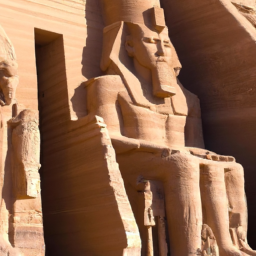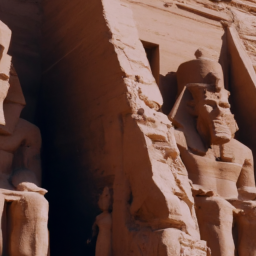“Experience the Ancient Wonders of Abu Simbel!”
Introduction
Abu Simbel is an ancient temple complex located in southern Egypt on the western bank of the Nile River. It was built by Pharaoh Ramses II in the 13th century BC as a lasting monument to himself and his queen, Nefertari. The complex consists of two massive rock-cut temples, the Great Temple of Ramses II and the Small Temple of Nefertari. The temples are renowned for their grandeur and beauty, and are considered to be one of the most impressive monuments of ancient Egypt. The temples were relocated in the 1960s to avoid their destruction by the rising waters of the Nile due to the construction of the Aswan High Dam. Today, Abu Simbel is a popular tourist destination and a UNESCO World Heritage Site.
Exploring the Ancient Wonders of Abu Simbel: A Guide to the Temples of Ramses II
The ancient temples of Abu Simbel, located in southern Egypt, are some of the most impressive monuments of the ancient world. Built by the great Pharaoh Ramses II in the 13th century BC, these two temples are a testament to the power and grandeur of the ancient Egyptian civilization.
The two temples of Abu Simbel are located on the western bank of the Nile River, about 280 miles south of Aswan. The larger temple, known as the Great Temple, is dedicated to the gods Amun, Ra-Horakhty, and Ptah, as well as to Ramses II himself. The smaller temple, known as the Small Temple, is dedicated to the goddess Hathor and to Ramses’ beloved wife, Nefertari.
The Great Temple is the larger of the two temples, measuring 98 feet high and 180 feet wide. It is composed of four large statues of Ramses II, each standing at a height of 65 feet. The entrance to the temple is flanked by two colossal statues of Ramses II, each with a height of 33 feet. Inside the temple, there are several chambers, including a hypostyle hall, a sanctuary, and a chapel.
The Small Temple is much smaller than the Great Temple, measuring only 32 feet high and 65 feet wide. It is composed of two statues of Ramses II, each standing at a height of 20 feet. Inside the temple, there are several chambers, including a hypostyle hall, a sanctuary, and a chapel.
Visitors to Abu Simbel can explore the temples and learn more about the ancient Egyptian civilization. The temples are open to the public from 8:00am to 4:00pm every day. Visitors should be aware that the temperatures in the area can be quite hot, so it is important to bring plenty of water and sunscreen.
The temples of Abu Simbel are a must-see for anyone interested in exploring the ancient wonders of Egypt. With their impressive size and intricate details, these two temples are a testament to the power and grandeur of the ancient Egyptian civilization.
The History and Significance of Abu Simbel: How the Temples of Ramses II Changed the Course of Ancient Egypt

Abu Simbel is an ancient temple complex located in southern Egypt, near the border with Sudan. It was built by the Pharaoh Ramses II in the 13th century BC, and is one of the most impressive monuments of ancient Egypt. The complex consists of two temples, dedicated to the gods Amun and Ra-Horakhty, and is renowned for its grandeur and intricate carvings.
The construction of Abu Simbel was a major undertaking for the ancient Egyptians. The two temples were carved out of a sandstone cliff, and the entire complex was decorated with intricate carvings and statues of Ramses II. The entrance to the complex is guarded by four colossal statues of the Pharaoh, each standing at over 20 meters tall. Inside the temples, there are a number of chambers and halls, decorated with scenes depicting Ramses II’s military victories and his relationship with the gods.
The construction of Abu Simbel was a statement of power and prestige for Ramses II. By building such an impressive monument, he was able to demonstrate his wealth and power to the people of Egypt. It also served as a reminder of his divine right to rule, as the gods were depicted as supporting him.
The construction of Abu Simbel had a lasting impact on the course of ancient Egypt. It was a symbol of the Pharaoh’s power and authority, and it helped to solidify his rule. It also served as a reminder of the importance of the gods in ancient Egyptian society, and it helped to spread the Pharaoh’s religious beliefs throughout the country.
Abu Simbel is an iconic monument of ancient Egypt, and it has been a source of fascination for centuries. It is a testament to the power and grandeur of the Pharaohs, and it has helped to shape our understanding of ancient Egyptian culture. The construction of Abu Simbel changed the course of ancient Egypt, and it continues to be an important part of the country’s history and culture.
Uncovering the Mysteries of Abu Simbel: Examining the Ancient Art and Architecture of the Temples of Ramses II
The Temples of Ramses II at Abu Simbel are some of the most impressive and awe-inspiring monuments of ancient Egypt. Built in the 13th century BC, these two temples are a testament to the power and grandeur of the Pharaoh Ramses II. The temples are located in the Nubian Desert, near the border between Egypt and Sudan, and are a popular tourist destination.
The two temples, the Great Temple and the Small Temple, are both dedicated to the gods Amun, Ra-Horakhty, and Ptah. The Great Temple is the larger of the two, and is dedicated to Ramses II himself. It is decorated with four colossal statues of the Pharaoh, each standing at over 20 meters tall. Inside the temple, there are a number of reliefs and statues depicting Ramses II in various scenes from his life.
The Small Temple is dedicated to Ramses II’s wife, Nefertari, and their four children. It is decorated with reliefs and statues of the royal family, as well as scenes from the gods. The entrance to the temple is flanked by two statues of the goddess Hathor.
The architecture of the temples is a testament to the skill of the ancient Egyptians. The walls are decorated with intricate reliefs and hieroglyphs, and the columns are carved in the shape of papyrus plants. The temples are also aligned with the sun, so that twice a year, on the Pharaoh’s birthday and coronation day, the sun’s rays penetrate the inner sanctum of the temple and illuminate the statues of the gods.
The Temples of Ramses II at Abu Simbel are a remarkable example of ancient Egyptian art and architecture. They are a testament to the power and grandeur of the Pharaoh, and a reminder of the skill and ingenuity of the ancient Egyptians.
Q&A
1. Where is Abu Simbel located?
Abu Simbel is located in southern Egypt, near the border with Sudan.
2. What is the significance of Abu Simbel?
Abu Simbel is an ancient temple complex built by Pharaoh Ramses II in the 13th century BC. It is considered one of the most impressive monuments of ancient Egypt and is a UNESCO World Heritage Site.
3. How was Abu Simbel saved from flooding?
In the 1960s, Abu Simbel was threatened by the rising waters of the Nile due to the construction of the Aswan High Dam. To save the temple complex, it was dismantled and relocated to a higher elevation.
Conclusion
Abu Simbel is an incredible example of ancient Egyptian architecture and engineering. Its two massive temples, dedicated to the gods Ra-Horakhty and Ptah, are a testament to the skill and dedication of the ancient Egyptians. The temples were built to honor the Pharaoh Ramses II and his queen Nefertari, and they remain a powerful symbol of the power and grandeur of the ancient Egyptian civilization. The temples of Abu Simbel are a must-see for anyone interested in ancient history and architecture.



